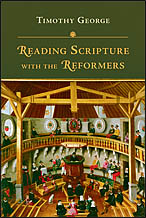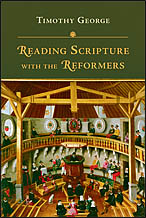 Timothy George, Reading Scripture with the Reformers (Downers Grove, IL: IVP Academic, 2011). $16.00, 272 pages.
Timothy George, Reading Scripture with the Reformers (Downers Grove, IL: IVP Academic, 2011). $16.00, 272 pages.
In the 1990s, InterVarsity Press launched the Ancient Christian Commentary on Scripture (ACCS) series. ACCS aims to publish a commentary on every book of Scripture, based on representative selections from the Church Fathers. The series’ publication is a salutary event for the entire Church, of course, but especially for the evangelical wing of that Church, which often fails to wrestle with, let alone acknowledge, the history of the interpretation of the Bible.
Now, InterVarsity is launching a new series: the Reformation Commentary on Scripture (RCS). The first published commentary is Volume 10: Galatians, Ephesians, which is entirely appropriate, since the theology of Apostle Paul can be said to have sparked the Reformation.
Reformation historian Timothy George is general editor of RCS, and he has published a companion volume to it called Reading Scripture with the Reformers. He aims to present “the story, or at least part of the story, of how the Bible came to have a central role in the sixteenth-century movement for religious reform that we call the Protestant Reformation” (p. 11). He notes three issues that recur throughout his narrative (pp. 13–14): (1) “the question of Scripture and tradition,” (2) “the desire to make the Bible available to everyone in the common languages of the day,” and (3) “how the Bible was used in the life and worship of the Protestant churches.”
George primarily uses biography to advance his narrative. Chapter 1 asks, “Why Read the Reformers?” We’ll return to George’s answer later. Chapter 2, “Ad Fontes!,” examines two 15th-century developments that made the Reformation possible: “the rediscovery of a vast store of ancient learning that included new methods of studying the Bible as well as other classical texts from the past” and “the invention and rapid development of printing” (p. 46). Chapters 3–8 then turn to the lives and thoughts of men (and a few women) influenced the ideas and practices of Protestantism: Desiderius Erasmus, Martin Luther, Philipp Melanchthon and other early Lutherans, Huldrych Zwingli and Radical Reformers, and John Calvin and his theological progeny. Though we speak of the Reformation (singularly), these men and women show that there were actually many Reformations (plural), united in their opposition to Roman Catholicism but divided among themselves along theological and practical lines.
Back to Chapter 1 and its question: Why read the reformers? One reason, of course, is historical: For better or worse, the Reformers have shaped the world in which we live. But for evangelical Christians especially, there is a more compelling, spiritual reason: “we share with them a common patrimony in the sacred Scriptures.” George goes on to write:
We listen to their struggles, musings and debates about the written Word of God as a way of better attending to the thing itself. From the reformers we learn that the true purpose of biblical scholarship is not to show how relevant the Bible is to the modern world, but rather how irrelevant the modern and postmodern world—and we as persons enmeshed in it—have become in our self-centered preoccupations and sinful rebellion against the God who spoke and still speaks by his Spirit through his chosen prophets and apostles (p. 42).
General readers interested only in historical issues will find George’s narrative a good entryway into the historical forces guiding and leading personalities of the Protestant Reformation. Christian readers interested in history and spirituality will find soul mates in the portraits George paints of men and women who, like us, wish “to point men and women both to the written Word in Scripture and to the living Word Jesus Christ” (p. 258).
P.S. If you found this review helpful, please vote “Yes” on my Amazon.com review page.

